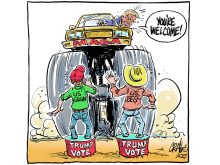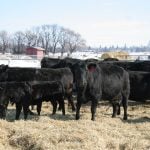EMBATTLED on all sides, Canadian hog producers have asked for $1 billion in emergency federal aid.
The request is unusual for an industry normally wary of aid and its potential to spark foreign trade challenges. The fact they are asking now shows they are indeed sailing stormy seas.
Some pressures are normal business risk, such as currency exchange rates and feed costs, while others are extraordinary challenges related to trade restrictions and consumer fears.
Industry restructuring and the federal-provincial Growing Forward risk management programs should address the business risk troubles. But the exceptional challenges presented by United States country-of-origin labelling and the H1N1 flu scare present a strong argument for special government assistance.
Read Also

Finding the sweet spot where ag science meets ag culture
Soon, many will look at practices such as seeding marginal acres to forage, growing cover crops and livestock integration and ask why they didn’t do this sooner.
Rarely has an industry faced so many challenges at once. Feed prices, while down from last year’s peaks, are still well above the five-year average and lately have rallied, sapping profitability from livestock producers.
The Canadian dollar is again strong, lowering profit from Canadian pork exports.
U.S. COOL rules are ruining the market for Canadian swine exports. Slaughter hog exports to the U.S. are down 64 percent this year. Weanling exports fell 29 percent.
With reduced competition from American packers and an ample supply of hogs, Canadian packers face little pressure to bid aggressively.
The global recession cut consumers’ demand for pork and other meats, adding further downward pressure on prices.
These pressures already had hog farmers culling their herds. On April 1, Canadian farms had 8.6 percent fewer pigs than they did last year at the same time. The herd is down 21 percent from its peak in 2006.
Canada had 8,300 hog operations on April 1, down about 1,000 from a year ago.
The industry is trying hard to align production with new market realities and there was hope for a reprieve this spring when the combination of reduced pork supply and seasonally strong meat demand for barbecuing would push hog producers’ bottom line into positive territory.
But then the H1N1 flu virus flared up in Mexico and authorities initially called it swine flu, causing baseless worries about eating pork and unjustified restrictions on North American pork exports. That drove hog prices lower again to the point where many are losing $30 per head or more, triggering the call for federal help.
But the federal government, which recently increased its deficit projection to $50 billion from $33.7 billion in January, has less capacity to help.
Last year it helped with a $50 million sow cull program and $150 million to make cash advance loans more easily available to livestock producers. But loans aren’t enough to patch the damage.
The Canadian hog industry is not a basket case like parts of the auto sector. It is among the most efficient in the world. It overbuilt when the loonie was weak and it must continue its painful restructuring to adapt and succeed in a changed market.
But without federal help it faces collapse and that would cost the economy more than an aid package. Investing to save the hog industry would be money well spent.
ruce Dyck, Terry Fries, Barb Glen, D’Arce McMillan and Ken Zacharias collaborate in the writing of Western Producer editorials.














